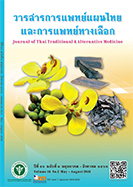Antifungal activity of Rhinacanthus nasutus (L.) Kurz extracts against dermatophytes N/A
Main Article Content
Abstract
Rhinacanthus nasutus (L.) Kurz (thongphanchang in Thai) has been used in Thai traditional medicine for the treatment of skin diseases and eczema. This plant exhibits the potent antifungal activity against dermatophytes. This study aimed to investigate the antifungal activity of R. nasutus extracts from various parts of the plant and determine the quantity of active substances for developing the extraction method to furnish the antifungal-rich extract. The dried leaves, stems and roots of R. nasutus were extracted with ethanol by maceration and ultrasonic-assisted extraction. The extracts were tested for their antifungal activity using three dermatophytes (Trichophyton rubrum, Trichophyton mentagrophytes, and Microsporum gypseum) by broth microdilution method. Each extract was used for HPLC fingerprint analysis. The root extract showed the most potent antifungal activity against the tested dermatophyte species. Purification and structure elucidation revealed that the active substances are rhinacanthins B, C, N, and Q. In addition, the ethanolic extract of dried root that was further separated with ethyl acetate afforded a rhinacanthins-rich extract. This extract exhibited excellent antifungal activity, comparable to rhinacanthin C (a major active substance). Therefore, this extraction method might be suitable for preparing a R. nasutus root extract in order to develop antifungal herbal formulations.
Article Details
References
2. Degreef HJ, DeDoncker PR. Current therapy of dermatophytosis. J Am Acad Dermatol. 1994;31:S25-30.
3. Petplai D, Tinnakorn Na Ayuthaya P, Bunsit J. List of herbal medicines and indications for primary health care service. Bangkok: Department of Medical Sciences; 1979. (in Thai)
4. Pruksakorn P, Settasupana K, Mekha N, Autthateinchai R, Dhepakson P, Herunsalee A. Antifungal activity of
ethanolic extracts from the rhizomes of Zingieraceae plants. J Thai Trad Alter Med. 2016;14(3):286-95. (in Thai)
5. 5. Pruksakorn P, Mekha N, Autthateinchai R,Dhepakson P. Antifungal activities of ethanolic extract
from the rhizomes of mango ginger (khamin-khao-pa, or Curcuma amada Roxb.) J Health Sci. 2017;26(2):438-6. (in Thai)
6. Thiangburanathum W. Dictionary of Thai Medicinal Plants. 5th ed. Bangkok: Aksornpittaya; 1999. 880 p. (in Thai)
7. Committee and teachers of the Thailand Association of Traditional Medicine School at Wat Phra Chetuphon
(Wat Pho) Tha Tian, Bangkok. Handbook of Thai pharmacy, Drug Act B.E. 2510 and ministerial
regulations. 2nd ed. Bangkok: Ampolpittaya; 1969. (in Thai)
8. Petplai D, Bunsit J, Weerachat N. Indigenous medicinal plants, part 1. 2nd ed. Bangkok: Medical Research
Division, Department of Medical Sciences, Ministry of Public Health; 1985. (in Thai)
9. Bukke S, PS R, GS, Kedam TR. The study on morphological, phytochemical and pharmacological
aspects of Rhinacanthus nasutus. (L) Kurz (A Review). J App Pharm Sci. 2011;1(8):26-32.
10. Kodama O, Ichikawa H, Akatsuka T, Santisopasri V, Kato A, Hayashi Y. Isolation and identification of an
antifungal naphthopyran derivative from Rhinacanthus nasutus. J Nat Prod. 1993;56(2):292-4.
11. Deepa N, Ravichandran V. Anti-fungal activity of various extracts of Rhinacanthus nasutus (l).kurtz. Nat Prod
Ind J. 2008;4(2):125-7.
12. Siripong P, Wongseri V, Piyaviriyakul S, Yahaufai J, Chanpai R, Kanokmedakul K. Antibacterial potential of
Rhinacanthus nasutus against clinically isolated bacteria from Thai cancer patients.Mahidol J Pharm Sci. 2006;33(1-4):15-22.13. Sendi A, Chen JL, Jolad SD, Stoddart C, Rozhon E, Kernan M, et al. Two new naphthoquinones with
antiviral activity from Rhinacanthus nasutus. J Nat Prod. 1996;59(8):808-11.
14. Thongchuai B, Tragoolpua Y, Sangthong P, Trisuwan K. Antiviral carboxylic acids and naphthoquinones from
the stems of Rhinacanthus nasutus. Tetrahedron Lett. 2015;56(37):5161-3.
15. Bhusal N, Panichayupakaranant P, Reanmongkol W. In vivo analgesic and anti-inflammatory activities of a
standardized Rhinacanthus nasutus leaf extract in comparison with its major active constituent rhinacanthin-C. Sonklanakarin J Sci Technol. 2014;36(3): 325-31.
16. Siriwatanametanon N, Fiebich BL, Efferth T, Prieto JM, Heinrich M. Traditionally used Thai medicinal plants:
In vitro anti-inflammatory, anticancer and antioxidant activities. J Ethnopharmacol. 2010;130(2):196-207.
17. Rao PV, Naidu MD. Rhinacanthus nasutus: a plant with potential activity in radical scavenging capacity. Curr
Trends Biotechnol Pharm. 2010;4(3):791-4.
18. Shyamal S, Latha PG, Suja SR, Shine VJ, Anuja GI, Sini S, et al. Hepatoprotective effect of three herbal
extracts on aflatoxin BI-intoxicated rat liver. Singapore Med J. 2010;51(4):326-31.
19. The Clinical and Laboratory Standard Institute. Reference method for broth dilution antifungal
susceptibility testing of filamentous fungi; approved standard. 2nd ed. CLSI Document M38-A2; 2008. 13 p.
20. Luplertlop N, Suwanmanee S. Dertmatophytosis: from bench to bedside. J Trop Med Parasitol. 2003;36:75-87.
(in Thai)
21. Sattar MA, Abdullah NA, Khan AH, Noor AM. Evaluation of anti-fungal and anti-bacterial activity of
a local plant Rhinacanthus nasutus (L.). J Biol Sci.2004;4(3):498-500.
22. Siripong P, Wongseri V, Piyaviriyakul S, Yahaufai R, Chanpai R, Kanokmedakul K. Antibacterial of
Rhinacanthus nasutus against clinically isolated bacteria from Thai cancer patients. Mahidol J Pharm Sci.2006;33:15-22.
23. Wisuitiprot W. Antifungal activity of Rhinacanthus nasutus extract against Malassezia sp. J Health Sci.
2012;31(3):521-8. (in Thai)
24. Wu TS, Tien HJ, Yeh MY, Lee KH. Isolation and cytitoxicity of rhinacanthin-A and -B, two anphthoquinones,
from Rhinacanthus nasutus. Phytocheistry. 1988;27(12):3787-8.
25. Wu TS, Hsu HC, Wu PL, Leu YL, Chan YY, Chern CY, et al. Naphthoquinone esters from the root of Rhinacanthus
nasutus. Chem Pharm Bull. 1998;46(3):413-8.
26. Wu TS, Hsu HC, Wu PL, Teng CM, Wu YC. Rhinacanthin-Q, a naphthoquinone from Rhinacanthus
nasutus and its biological activity. Phytochemistry.1998;49(7):2001-3.
27. Horii H, Suzuki R, Sakagami H, Tomomura M, Tomomura A, Shirataki Y. New biological activities of
rhinacanthins from the root of Rhinacanthus nasutus. Anticancer Res. 2013;33:453-60.


